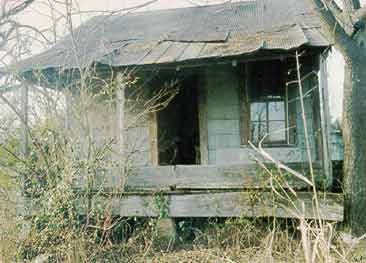
Sharecropper's Shack in Mississippi Delta
Living Conditions
Living conditions in the North, while crowded, were very similar to housing conditions
in the South. Tenement housing in Chicago, and stories of overcrowding in apartments
portray terrible living conditions. In the North, however, the living conditions
were not drastically different from the South. African Americans changed residences
once they were settled in the North. Many started started out in the countryside,
moved from place to place to find the most favorable circumstances. In the South,
many men left their families to live and work with the railroad companies. Some
families moved to towns, such as Mound
Bayou in the South and stopped in southern
cities, such as Memphis on their journey North. In Northern cities, migrants
congregated in neighborhoods such as Bronzeville, which
quickly became overcrowded and unsanitary. Living conditions were often used
as a measure of the success or failure of the migration. A family succeeded
when they secured a place of their own. Troubles in the city were often marked
by repeated moves and shared living spaces with other migrants. But, even those
who found settled housing, these accomodations wer always substandard to white
accomodations.
| In the South, most migrants had lived in three or four room cabins. It was not uncommon for as many as five people to sleep in a single room. Although the space outside of the home may have been vast, the houses were cramped and crowded, and often unsanitary. The living spaces of African Americans in the South were generally not their own. There were relatively few African American land owners in the Mississippi Delta, as the Delta encouraged renting. Access to space was extremely limited in the Delta. Many moved to southern cities in hopes of finding a better life than the one offered them in rural areas. Once in the Southern cities, however, African Americans continued to be faced with poor living conditions. Technological innovations which benefitted many in southern cities were not available to African Americans. They still occupied the unhealthiest living conditions. Many still relied on water from wells, and did not benefit from the development of sewers and water systems. Tenement housing was not unique to Northern cities. Cities in the South shared the qualities associated with tenement housing in the North. |
Sharecropper's Shack in Mississippi Delta |
| The majority of migrants settled on the South side of Chicago, what became known as the Black Belt. The boundaries that distinguished this small section of Chicago were mainly street crossings, that once crossed marked an entrance into a different neighborhood. Often, drains overflowed into streets causing the streets to become unsanitary rivers that children often played in. Living spaces were small and often infested with rats and insects. The density of people in neighborhoods like Bronzeville, was often twice that of the surrounding white neighborhoods. These neighborhoods often butted the most prestigious of white neighborhoods, with only a fence to delineate the tenement or apartment from the backyard of a wealthy white homeowner. |
Russell Lee. "Children Playing in the Water Backed Up in the Gutter in the South Side," Chicago. 1941. FSA. Library of Congress. |
|
Russell Lee. "Family on Relief," Chicago. 1941. FSA. Library of Congress. |
Chicago provided migrants more space than they had in the South. However, as more and more people arrived in Chicago, housing became overcrowded. Six-flats, apartments buildings with three floors and two apartments on each floor, would be broken up into more and more smaller apartments as the housing shortage worsened. Despite this crowding, Chicago housing still offered standard amenities which migrants lacked in the South. Electricity and plumbing were standards in the North. In the North, some migrants lived in railroad flats, which were apartments with one room right after the other, so that to get to the room in the back one would have to walk through all the rooms preceding that one. This type of apartment is reminiscent of shotgun houses in the South, houses where there was a wide open room in the center and another room on either side. |
|
Kitchenette Building by Gwendolyn Brooks We are things of dry hours and the involuntary
plan, |
Russell Lee. "Kitchenette Apartment," Chicago. 1941. FSA. Library of Congress. |
These apartment or tenements were most often "kitchenettes." The basic idea of a kitchenette being, everything enclosed in one room, including the kitchen. Similar to what we call an efficiency apartment today, except a bit smaller and housing more people. Families of 4 and up lived in these small spaces that they called their home. Rat infested, in disrepair, and dilapidated, though they may be, they belonged to the migrants as their own.
Whatever the living conditions, the freedom of the mind that was allowed within the space meant much more. The
personal freedom associated with the North made it so attractive that the accommodations were not of huge importance
to migrants. Though the living spaces were often the worst in the city, this option was often more appealing to
migrants than living in the South where both physical and mental space was severely circumscribed.
|
|